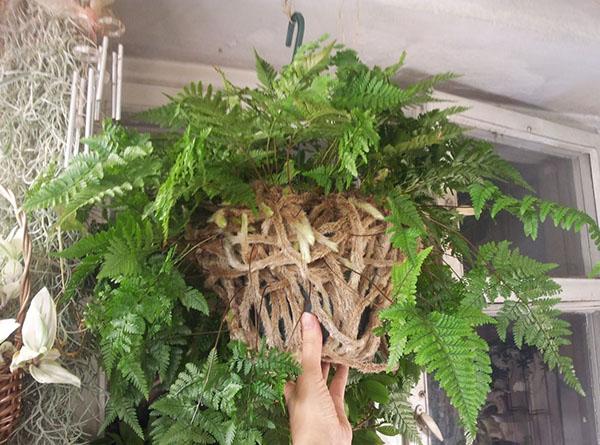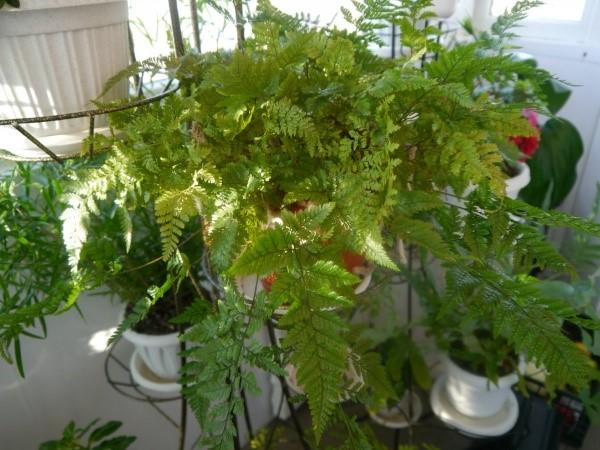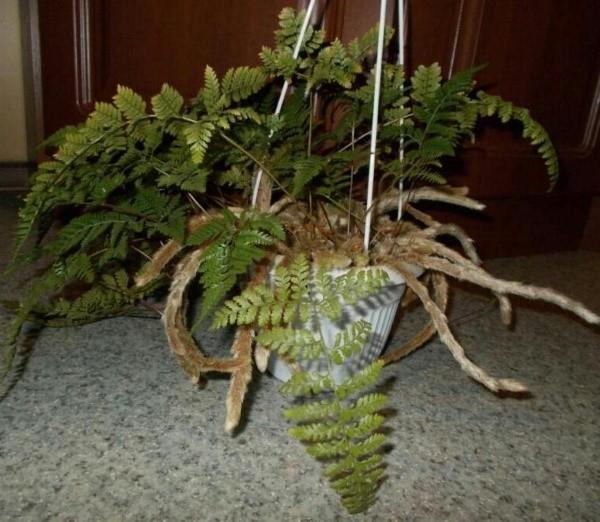Davallia - home care for a beautiful spider fern
 Thanks to their chic decorative look and lush deciduous cap, ferns are grown by many growers. Among them, it is worth noting such a plant as davallia, caring for which at home requires certain knowledge. Increased requirements for keeping conditions often lead to the fern dying. A beautiful green bush brought from the store begins to dry out after a while at home. But this can be avoided if you know what davallia loves and what it should be protected from.
Thanks to their chic decorative look and lush deciduous cap, ferns are grown by many growers. Among them, it is worth noting such a plant as davallia, caring for which at home requires certain knowledge. Increased requirements for keeping conditions often lead to the fern dying. A beautiful green bush brought from the store begins to dry out after a while at home. But this can be avoided if you know what davallia loves and what it should be protected from.
The fern got its name thanks to the famous botanist E. Davallu.
What does davallia look like - characteristic features of the plant

For the pubescent surface of the roots hanging from the pot, davallia is also called fern hare paws. They really look like the legs of an animal, and also like spider legs.
 Otherwise, davallia grows like all ferns. Its aerial part consists of many openwork leaves with toothed segments. They appear in the spring-summer period, and in the winter the bush stops its development. Adult ferns are very lush, with a wide crown, but an average height of about 20 cm, although there are specimens up to 50 cm.At the same time, the length of the air roots in some davallia species can reach 90 cm.
Otherwise, davallia grows like all ferns. Its aerial part consists of many openwork leaves with toothed segments. They appear in the spring-summer period, and in the winter the bush stops its development. Adult ferns are very lush, with a wide crown, but an average height of about 20 cm, although there are specimens up to 50 cm.At the same time, the length of the air roots in some davallia species can reach 90 cm.
Vayi are capable of changing their color. At a young age, they are bright green, but gradually acquire a yellowish tint.
Popular types of epiphytic fern
The Davalliev family, to which the epiphyte belongs, is very few in number. It has about 4 dozen ferns, which differ in size and shape. But due to the demanding nature, most species grow only in the wild.
In indoor floriculture, only a few, the most unpretentious, ferns have taken root, among which:
- Davallia is dense. The leaves are three times pinnate, rather dense, similar to wide triangles on long petioles. Height up to 50 cm and width up to 25 cm.

- Canary davallia. The frond is openwork, fourfold pinnately dissected, similar to an elongated rhombus. The length of the leaf is almost equal to the length of the petiole (about 30 cm).

- Davallia is blistered. Differs in a spiral-shaped brownish root. The leaves are slightly swollen, up to 25 cm long and about 15 cm wide.

- Fijian dawallia. One of the tallest and darkest ferns, capable of growing up to 90 cm. But it has thin, but strong, petioles that hang beautifully from a hanging pot. Another feature of the species is the ability to update fronds annually, getting rid of old ones.

- Davallia dissected. Herbaceous appearance, one of the lightest. Petioles are yellow-green with shiny leaves about 30 cm long.

Epiphyte requirements for conditions of detention
 Caring for davallia fern at home, first of all, implies creating comfortable conditions for it. The lighting should be good, but diffuse. On the southern windows, the leaves will dry out and be covered with brown spots from sunburn. On the northern side, davallia will be able to live, but it will grow more slowly and will not be so lush.
Caring for davallia fern at home, first of all, implies creating comfortable conditions for it. The lighting should be good, but diffuse. On the southern windows, the leaves will dry out and be covered with brown spots from sunburn. On the northern side, davallia will be able to live, but it will grow more slowly and will not be so lush.
The oriental sill is the perfect spot for a fern. It also develops well under artificial lighting.
Davallia is distinguished by a high demand for air humidity, but at the same time it tolerates high temperatures well. If the room is even warm up to 40 ° C, the epiphyte is not afraid. But only on condition that the air humidity is at least 70%. On average, summer comfort values are 22 ° C. But the fern prefers to winter in light coolness, but not lower than 15 ° C. In colder conditions, it will drop foliage.
It is better to choose a wide pot for davallia, because its underground roots are superficial. Plastic containers should be left for other colors, preferring natural materials. Despite the love of moisture, drainage and the presence of holes in the vessel are mandatory requirements.
The davallia indoor fern needs breathable, light and slightly acidic soil.
You can purchase a special fern substrate or prepare it at home by mixing:
- leafy and sod land;
- sphagnum;
- peat;
- sand;
- some charcoal.
You can also grow davallia in a mixture for orchids or bromeliads.
The epiphytic abilities of davallia make it possible to completely abandon the soil as such. You can grow a fern without soil and a pot, planting it on a wood base. It can be a driftwood or a small tree stump with a hollow. Sphagnum or coconut fiber should be placed under the bush itself and secured with a rope. You can also overlay moss and driftwood directly around the plant.
Davallia - home care
 If you immediately take care of the proper conditions of detention, caring for the epiphyte in the future will not cause much trouble.
If you immediately take care of the proper conditions of detention, caring for the epiphyte in the future will not cause much trouble.
For the bush to actively grow new fronds, it is enough:
- In the summer, spray the foliage regularly, especially if the pot is outside. In the room next to the fern, you can put a tray with wet expanded clay. It will maintain the required humidity level.
- Sprinkle with lukewarm water as the topsoil dries. If wintering is cool, watering should be reduced. Caring for dawallia growing at home on a snag is somewhat different. Such a plant is watered by immersing the roots in a basin of water.
- From late spring to late summer, feed the bush every 2 weeks. Mineral complexes are suitable for decorative deciduous plants. In this case, the concentration of the working solution should be two times lower.
- When the underground roots begin to bulge out of the old flowerpot, transplant the bush into a wider container. Young epiphytes are transplanted annually, and adults, overgrown bushes - every 3 years.
The fern does not need pruning. It is enough just to remove dry leaves in time so that they do not spoil the appearance of the bush.
Dawallia breeding methods
You can dilute a whole collection of epiphytes using:
- Delenok. An adult bush in the spring, during transplantation, must be divided into parts with a knife. Each section should have at least 1 sheet and roots about 7 cm long.

- Dispute. They need to be collected after ripening by spreading paper under the sheet and shaking the vayu. Then the spores should be slightly dried, sown in peat soil and covered with a cap. After sprouting, the greenhouse can be opened. The seedlings will be ready for transplanting when they grow up to 5 cm.

- Leaf cuttings. Freshly cut healthy frond should be rooted immediately in light soil. The stalk should be kept in the greenhouse until it takes root.

- Air spine.The procedure is similar to rooting a leaf, only the root is not buried. You just need to put it on the surface of the substrate and lightly press down with a stone (expanded clay).

Summing up, it can be noted that taking care of davallia at home in general will not be particularly difficult. Providing the fern with warmth and high humidity, all that remains is to maintain these conditions. In gratitude, the bush will delight you with dense thickets of green wai and original spider paws.